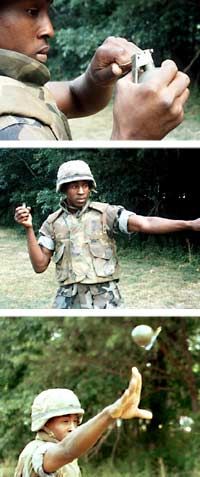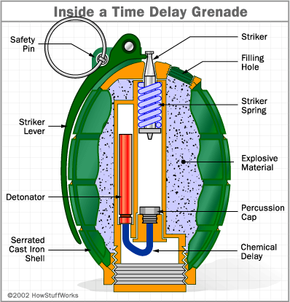Time-Delay Grenade
The most common type of grenade on the battlefield is thetime-delay fragmentation anti-personnel hand grenade. The primary function of this grenade is to kill or maim nearby enemy troops. To ensure maximum damage, the grenade is designed to launch dozens of small metal fragments in every direction when it explodes.
These sorts of grenades, which played a major role in World War I, World War II, Vietnam and many other 20th century conflicts, are designed to be durable, easy to use and easy to manufacture. The conventional design uses a simplechemical delay mechanism. The diagram below shows a typical configuration of this system, dating back to the first World War.
Advertisement
The outer shell of the grenade, made ofserrated cast iron, holds achemical fuze mechanism, which is surrounded by areservoir of explosive material. The grenade has afilling holefor pouring in the explosive material.

The firing mechanism is triggered by a spring-loadedstrikerinside the grenade. Normally, the striker is held in place by thestriker leveron top of the grenade, which is held in place by thesafety pin. The soldier grips the grenade so the striker lever is pushed up against the body, pulls out the pin and then tosses the grenade. Here's what happens inside once the grenade is released:
- With the pin removed, there is nothing holding the lever in position, which means there is nothing holding the spring-loaded striker up. The spring throws the striker down against thepercussion cap. The impact ignites the cap, creating a small spark.
- The spark ignites a slow-burning material in the fuze. In about four seconds, the delay material burns all the way through.
- The end of the delay element is connected to thedetonator, a capsule filled with more combustible material. The burning material at the end of the delay ignites the material in the detonator, setting off an explosion inside the grenade.
- The explosion ignites the explosive material around the sides of the grenade, creating a much larger explosion that blows the grenade apart.
- Pieces of metal from the outer casing fly outward at great speed, imbedding in anybody and anything within range. This sort of grenade may contain additional serrated wire or metal pellets for increased fragmentation damage.
Time-delay grenades are very effective, but they do have some significant disadvantages. One problem is theirunpredictability: In some chemical fuzes, the delay time may vary from two to six seconds. But the biggest problem with time-delay grenades is that they give the enemy an opportunity tocounterattack. If a soldier doesn't time a grenade toss just right, the enemy may pick it up and throw it back before it explodes.
For this reason, soldiers must useimpactgrenades in certain situations. An impact grenade explodes wherever it lands, so there is no chance for the enemy to throw it back. In the next section, we'll see how this sort of grenade works.



